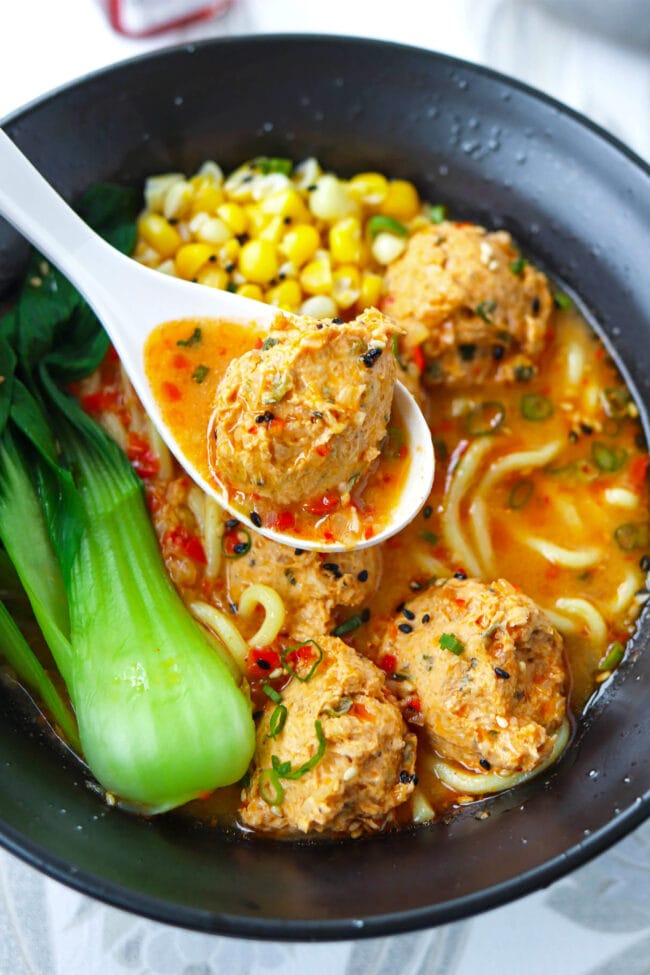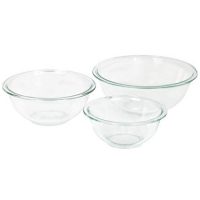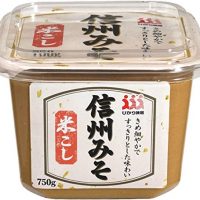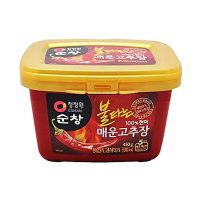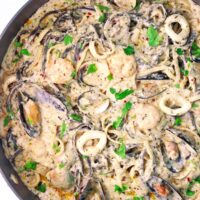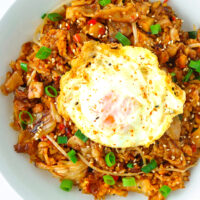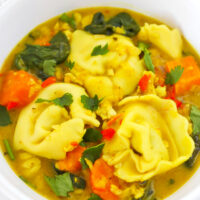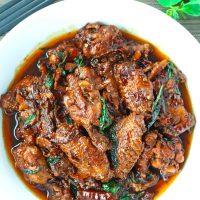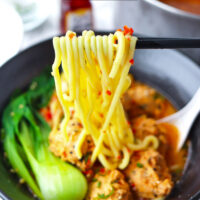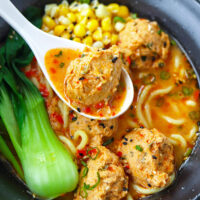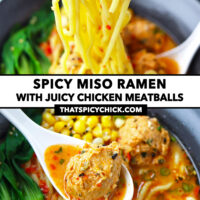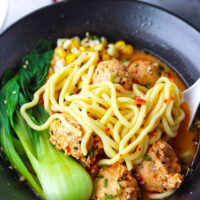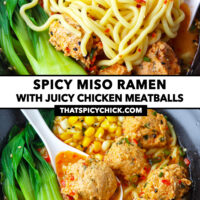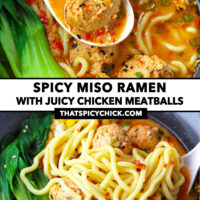Spicy Miso Ramen with Chicken Meatballs
This post contains affiliate links.
This Spicy Miso Ramen is made with fragrant aromatics, juicy chicken meatballs, and slippery ramen noodles in a flavorful savory-spicy and creamy miso broth! It’s quick and easy to make in 35 minutes, exploding with flavor, and incredibly warming and comforting!
Juicy chicken meatballs, slippery and hearty ramen noodles, and an EPIC tasty broth that’s super flavorful and warming on a chilly or rainy day! Actually, this Spicy Miso Ramen is the perfect quick and easy meal on any day really! 😍
It’s made with mostly healthy ingredients, quick and easy to whip up on any given weeknight, and so tasty due to cooking the chicken meatballs directly IN the flavorful broth! Not only do the meatballs end up being more succulent this way, they impart flavor into the broth and make it even more delicious.
The soup is infused with the savory umami notes of white miso paste and soy sauce, nutty and creamy sweetness of peanut butter, and a kick of heat from gochujang. It’s also seasoned with warming fresh aromatics like garlic, ginger, shallots, and a few fresh chilies. I’ve also added milk to make it wonderfully silky and give it a subtle creamy texture.
The ramen bowls are finished off with bok choy, spring onion, and sweet corn to balance out the savory-spicy flavors, toasted white and black sesame seeds, and a drizzle of sesame and chili oil. But feel free to customize this and use any of your favorite ramen noodle toppings!
Is this traditional ramen?
Although it’s not the traditional way to make ramen which takes longer and requires hours of simmering bones in water to make the broth, this Spicy Miso Ramen is a quick version that is incredibly satisfying and filling. It’s the type of meal you make when you don’t want to spend too much time cooking but want to eat something REALLY GOOD!
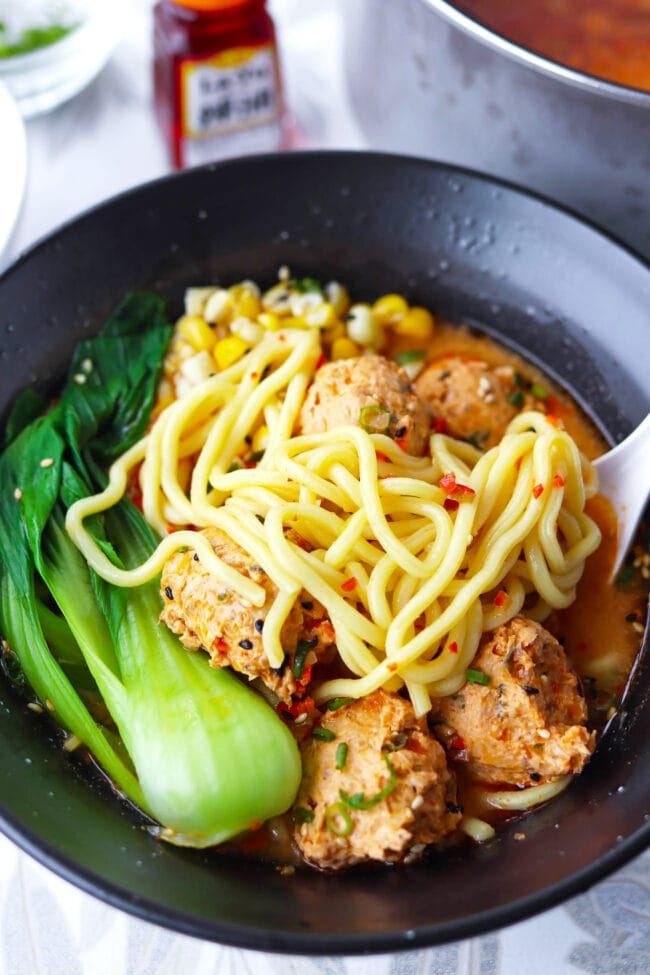
Why This Recipe Works
- Quick and easy. It’s ready in just 35 minutes!
- Flavorful. Cooking the meatballs directly in the soup makes the broth tastier and more flavorful.
- Skillful technique. Mixing the pastes with water before adding to the broth makes allows them to seamlessly integrate. You don’t need to struggle to break the pastes down with a spatula while making the soup.
- Silky broth. Adding milk makes the soup wonderfully smooth and slightly creamy. It adds a subtle flavor nuance and balances out the heat from the spicy ingredients.
- Hearty, filling and satisfying! It’s the perfect meal for a cold day and guaranteed to warm up your insides!
Ingredient Notes and Substitutes
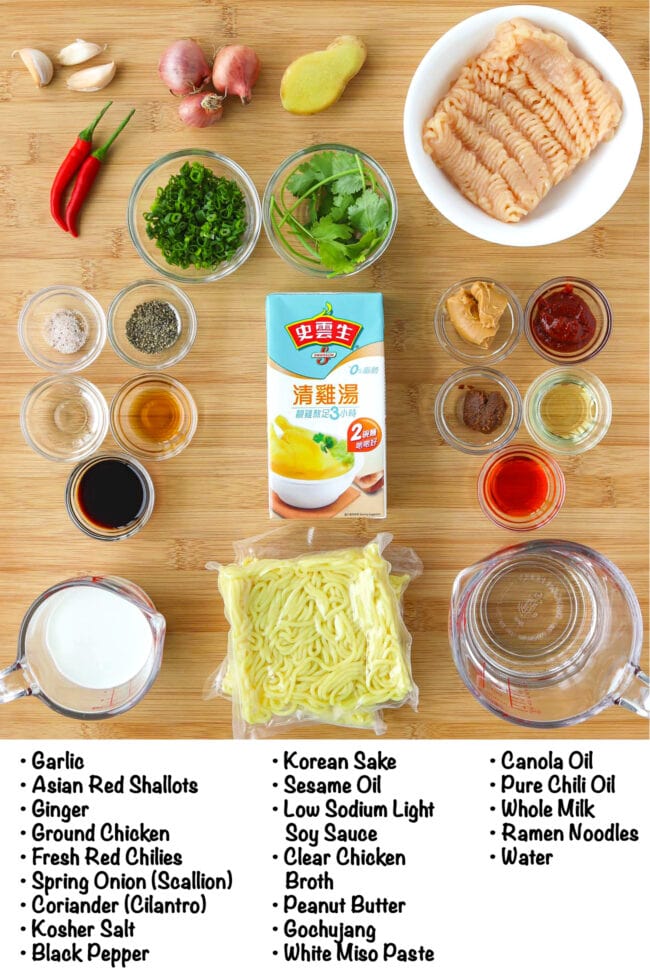
For the Chicken Meatballs:
- Ground Chicken: I used ground chicken, but ground turkey or other ground meat would work just as well. (See ‘Variations’ section below for other protein options).
- Asian Red Shallots: Or use regular shallots. Alternatively, yellow or red onion can be used in a pinch.
- Korean Sake: This is a Korean cooking wine that’s used to tenderize and bring out the flavor in meats. You could use a Japanese sake instead too, or omit it if you rather not cook with alcohol.
- Gochujang: This addictive and popular spicy fermented Korean chili paste probably needs no introduction. It adds a tiny kick of heat to the meatballs, but is also used in the broth to make it flavorful and spicy. These days gochujang can be found in most mainstream supermarkets. Use a GF certified gochujang such as Wholly gochujang if needed.
- Coriander (Cilantro): Omit if you’re not a fan. No biggie as there’s plenty of flavor in these meatballs already!
For the Spicy Miso Ramen Soup:
- Aromatics: Just some garlic, ginger, fresh red chilies and an Asian red shallot. (See note above for shallot substitutes.) I used Thai Bird’s Eye red chilies, but feel free to use any hot red chilies you can get in your area. You can omit them or use less depending on your heat level preference.
- White Miso Paste: Known as shiro miso or kome miso, this fermented Japanese soybean paste adds savory umami notes and a mild nutty sweetness to the soup. Look for it in a regular or Asian supermarket or a specialty Japanese ingredients grocery store.
- Creamy (Smooth) Peanut Butter: To add creamy and nutty flavors! Alternatively, use an Asian white sesame paste (like the one used for Spicy Dan Dan Noodles) or another nut butter. I highly recommend using a commercial peanut butter with added sugar and salt over a natural one. It will result in a more creamy and cohesive soup that isn’t grainy.
- Low Sodium Light Soy Sauce: Low sodium so that the salt level can be controlled better. Use a gluten-free soy sauce if needed.
- Canola Oil: Or use any other neutral cooking oil.
- Pure Chili Oil: This is a pure chili oil without any seeds or flakes. You can use a Chinese or Japanese pure chili oil (La-yu). Omit for a milder broth.
- Chicken Broth: I like to use a store-bought Asian-style clear chicken broth for my Asian noodle soups. A store-bought pork bone broth would be just as tasty! Feel free to use a regular western style chicken broth, either store-bought or homemade. If using a low sodium broth, you may need to add a little salt to taste.
- Whole Milk: The secret ingredient that makes the spicy miso ramen broth super silky and creamy! Traditionally soy milk is added to creamy style ramen noodle soups. However, I’ll admit that I’m not a fan of soy milk. Hence, I used regular whole milk as I always have it in my fridge. You can use soy milk if you like or any other plant-based milk.
- Ramen Noodles: I used vacuum sealed packs of fresh ramen noodles. They’re already cooked and just need a few brief minutes in a pot of boiling water to loosen the strands up. You can find them in an Asian supermarket and some mainstream supermarkets that are well-stocked with international ingredients. You could also use dry ramen noodles instead. Simply discard the seasoning packet if it comes with it and just cook the ramen brick in some boiling water.
- Optional toppings: I like my spicy miso ramen bowls to be topped with blanched bok choy and spring onion (scallion – green parts only) for some greenery, sweet corn kernels, and toasted white and black sesame seeds. Finally, a drizzle of sesame oil and pure chili oil to finish elevates all the flavors and adds that extra OOMPH-factor! Feel free to switch up the toppings and use other veggies like sliced seared shiitake mushrooms, blanched snow peas, sugar snap peas, etc. Other topping ideas include half of a soft boiled egg for each bowl, fresh mung bean sprouts, or crushed red pepper flakes for all the spice lovers out there.
Full ingredient list and amounts are in the recipe card below.
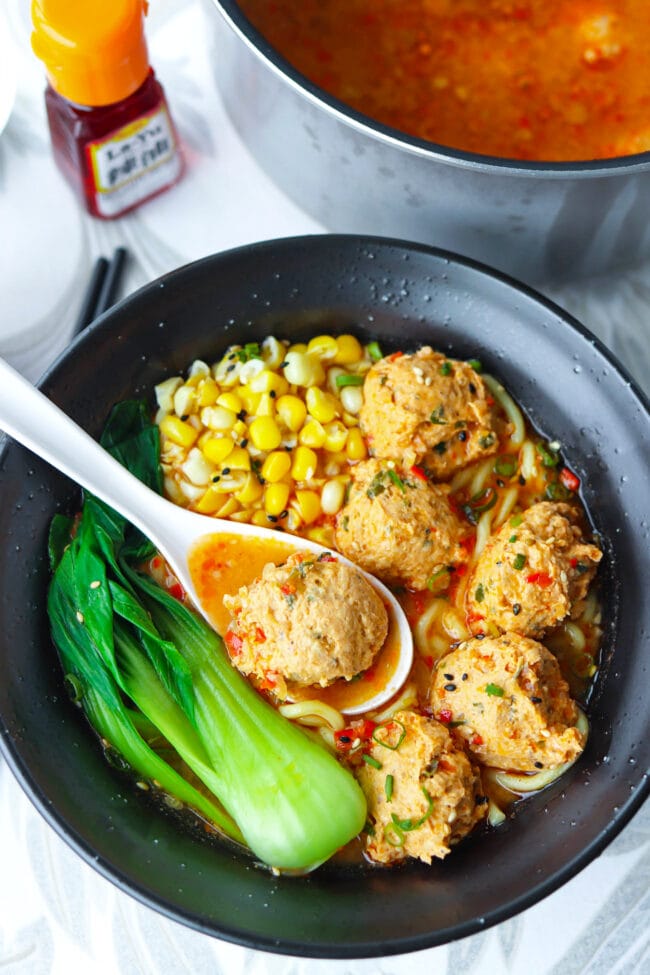
How to Make Spicy Miso Ramen with Chicken Meatballs
1. Mix the chicken meatballs ingredients. Combine all the ingredients for the chicken meatballs in a medium-sized mixing bowl. Mix well to combine and the texture of the meat mixture is smooth.
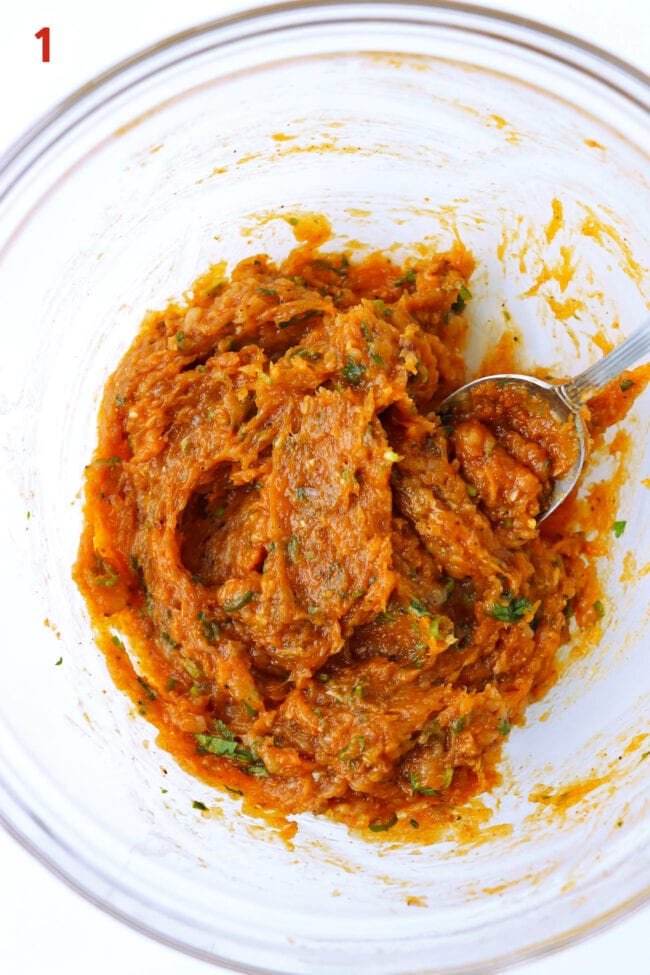
2. Make the sauce. Combine the white miso paste, peanut butter, gochujang, low sodium light soy sauce and warm water in a measuring glass. Mix thoroughly until the pastes have broken down.
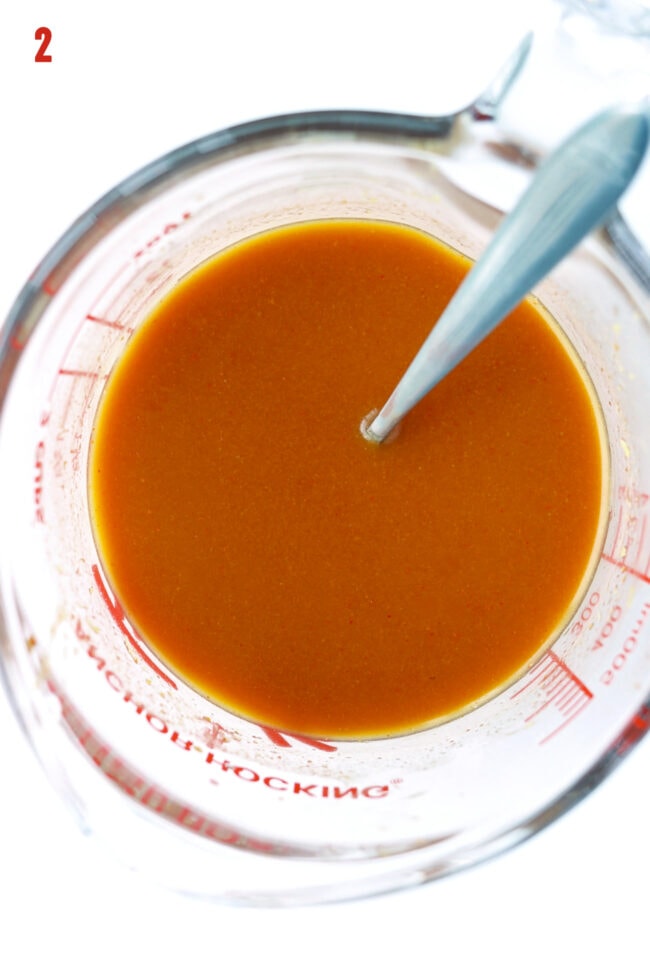
3. Sauté aromatics. In a bit of canola oil and chili oil (if using) until fragrant.
4. Build the soup. Pour in the chicken broth and sauce mixture, stir to combine.
5. Add milk. Stir in the milk until evenly combined. Let the broth heat up for a few minutes (it should not be boiling), then reduce the heat.
6. Cook the meatballs. Using two teaspoons, scoop up the meat mixture on one and use the other to slide the meatball into the soup. Repeat until all the meatballs are in the soup and cook for a few minutes until they are just cooked through.
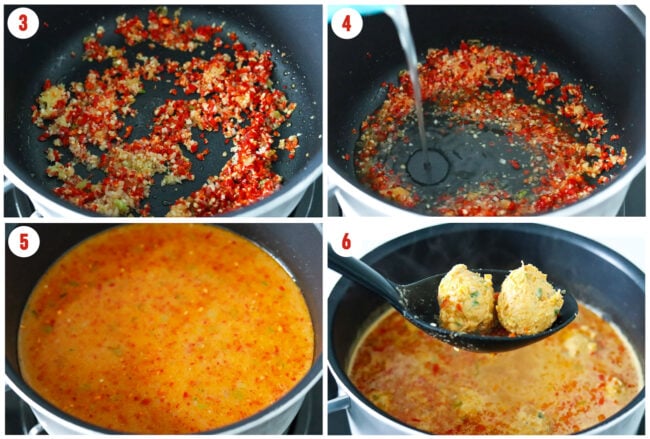
7. Cook the noodles and veggies. Cook the ramen noodles according to package instructions in a separate pot of boiling water. During the last 30 seconds, add the bok choy and blanch briefly. Drain and divide the noodles and greens evenly into bowls. If topping with sweet corn kernels too, bring water to a boil in the pot again and blanch them for 2 minutes. Drain and run cold water over the corn kernels to “shock” them.
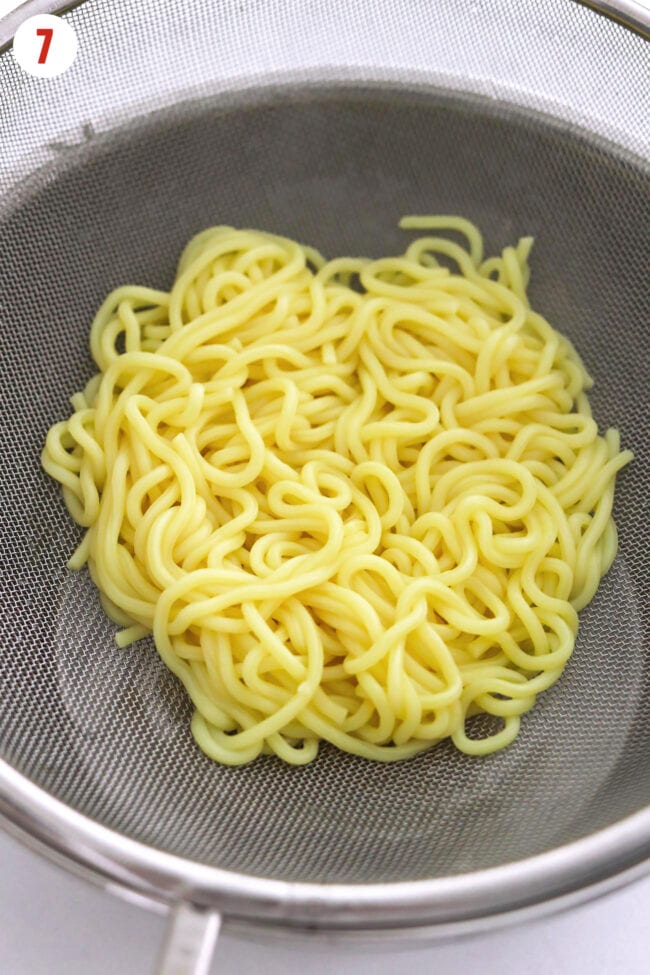
8. Serve! Ladle the spicy miso soup evenly over the noodle bowls and top with the bok choy, sweet corn, and spring onion. Drizzle with sesame and pure chili oil if desired and sprinkle with toasted white and black sesame seeds. Then serve and enjoy!
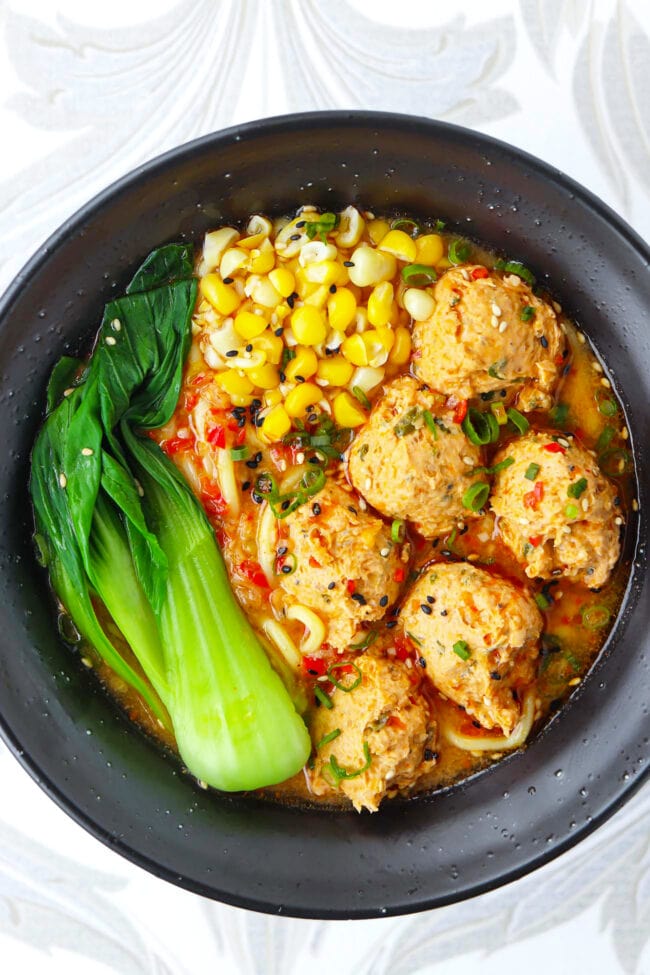
Full detailed instructions are in the recipe card below.
Cook’s Tips
- Adjust spice level to taste. Use less of the (or omit) fresh red chilies and omit the chili oil for both cooking the soup and topping to make it milder. You can also use just 1 tablespoon of gochujang for the broth.
- Don’t let the broth boil rapidly. It will cause the milk to split. You only need it to be hot and barely simmering to cook the meatballs.
- Work the proteins in the meat. To yield juicy meatballs, lift the meatball meat mixture and slap it against the bowl a few times. Working the proteins this way instead of just constantly mixing to combine the ingredients will ensure you have smooth and tender meatballs.
- Add more milk for a creamier broth. If you prefer a creamier broth, add ¾ to 1 cup of milk instead of the ½ cup I’ve indicated.

FAQs
This version is pretty hot and spicy due to incorporating fresh red chilies along with the gochujang in the broth. However, the spice level is adjustable. Simply omit or use less of the chili oil for cooking, fresh red chilies, and gochujang to make a milder spicy miso ramen.
Not all ramen noodles are fried. The fresh ramen used in restaurants are not fried, nor is the ramen noodles that come in vacuum sealed pack. However, dried instant ramen noodle bricks are fried to partially cook and dehydrate them.
White miso paste is best for making the ramen broth because it is milder and less salty than red miso paste and other darker varieties such as hatcho miso. Red miso paste may overpower the ramen broth, which is why I do not recommend using it.
Ideally, this ramen is best eaten immediately after cooking. There is risk of the milk splitting when reheating the leftover soup unless you are using full-fat coconut milk. That being said, you can store the spicy miso soup in a sealed airtight container in the fridge for up to 2 days if needed. Cook the noodles when ready to serve and reheat the broth over medium heat in a pot on the stovetop until hot throughout. Be careful to not let the broth boil rapidly when reheating. Do not store the noodles and soup together in the fridge as the noodles will absorb the soup and bloat over time.
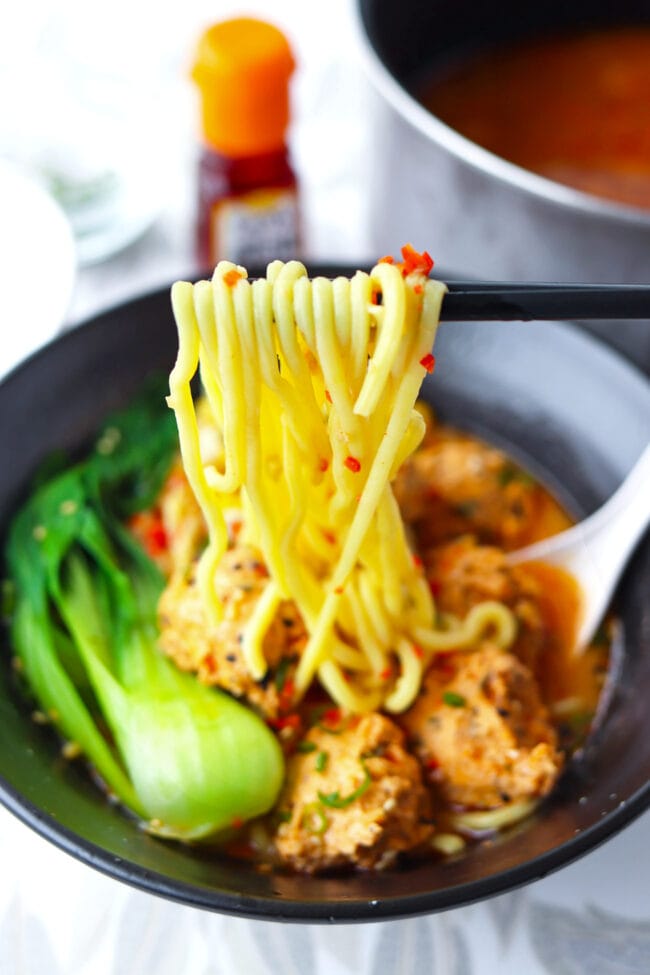
Variations
- Use a different protein for the meatballs. Shrimp paste made by finely chopping shrimp, ground pork, beef, or turkey or a combination of these meats can be used instead of chicken.
- Use dou ban jiang instead of gochujang. Sichuan Pixian dou ban jiang (fermented chili bean paste) would change the flavor profile but still be a delicious swap! Even Lee Kum Kee’s chili bean paste would work well. You can also opt to make my Spicy Dan Dan Noodles instead, which has dou ban jiang and peanut butter incorporated in the broth.
- Use soy milk or other plant-based milk. Oat milk, almond milk, or even unsweetened full-fat coconut milk would taste great!
- Use instant dry ramen bricks. If you can’t get your hands on fresh or vacuum sealed packs, dry ramen noodle bricks would work. Discard the seasoning packs that come in the packet and just boil the noodles according to package instructions. I don’t recommend cooking the noodles directly in the soup as they will release starch as they cook and make the broth too starchy.
- Make it gluten-free: Use a gluten-free soy sauce and gochujang. For gluten-free ramen noodles options, you can use soba (buckwheat) noodles or brown rice and millet ramen. They’re both easy to find in most mainstream grocery stores.
- Make it vegetarian: Omit the meatballs ingredients and use veggie broth. Top your bowl of spicy miso ramen with crispy pan-fried tofu or tempeh instead.
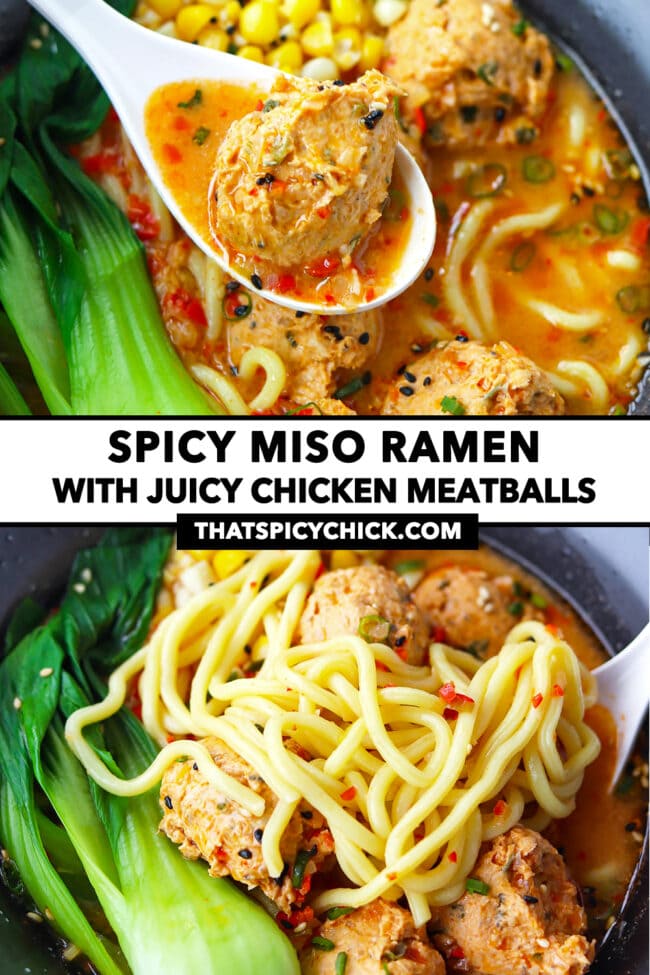
More Noodle Soups
- Thai Glass Noodle Soup (with Chicken & Prawn Meatballs)
- Japanese Curry Udon
- Spicy Udon Noodle Soup with Chicken & Mushrooms
- Spicy Curry Laksa
- Khao Soi Gai
- Or browse the entire Noodle Soup and Noodle recipe collections.
MADE THIS RECIPE? If you make this recipe, leave a comment below and let me know how you liked it! Take a photo and tag it with @thatspicychick on Instagram and hashtag it #thatspicychick and I’ll be sure to share your masterpiece!
STAY CONNECTED! You can also follow me on Pinterest, Facebook or Instagram. Sign up for my email list to get my latest recipe in your inbox weekly!
PrintSpicy Miso Ramen with Chicken Meatballs
Juicy chicken meatballs, slippery and hearty ramen noodles, and an EPIC tasty miso broth that’s super flavorful and warming! It’s ready in just 35 minutes and so delicious on any given weeknight!
- Prep Time: 15
- Cook Time: 20
- Total Time: 35 minutes
- Yield: 3 1x
- Category: Dinner
- Method: Simmer
- Cuisine: Asian-inspired
Ingredients
For the Chicken Meatballs:
- 2 Garlic cloves – grated
- ½ TBLS grated Ginger
- 2 Asian Red Shallots – finely chopped
- 2 TBLS finely chopped Coriander (Cilantro)
- 2 TBLS Spring Onion – finely chopped
- 8.5 ounces / 240 grams Ground Chicken
- 1 TBLS Low Sodium Light Soy Sauce
- 1 TBLS Gochujang (Korean Hot Pepper Paste)
- ½ TBLS Korean Sake (or Japanese Sake)
- ¼ TSP Kosher Salt (use half the amount if using iodized table salt)
- ¼ – ½ TSP freshly cracked Black Pepper
- 1 TSP Sesame Oil
For the Spicy Miso Ramen Broth:
- 1 Asian Red Shallot – finely chopped
- 1 Spring Onion (Scallion/Green Onion) – finely chopped, white and green parts separated
- 2 Garlic Cloves – minced
- ½ TBLS grated Ginger
- 2–10 fresh Red Chilies (optional), to taste – finely chopped
- ½ TBLS White Miso Paste
- 1.5 TBLS Creamy (Smooth) Peanut Butter
- 1.5 TBLS Gochujang
- 1 TBLS Low Sodium Light Soy Sauce
- 1 cup / 237ml Warm Water
- 1 TBLS Canola Oil (or any other neutral cooking oil)
- ½ TBLS Pure Chili Oil (optional)
- 2 cups / 500ml Chicken Broth (or Pork Bone Broth)
- ½ cup / 118ml Whole Milk
To Assemble the Noodle Bowls:
- 320 grams/11.28 ounces Ramen Noodles (I used 2 vacuum sealed packs of fresh ramen noodles– see notes*)
- 3–4 pieces blanched Bok Choy (or other Asian greens such as choy sum, Chinese Broccoli, etc.)
- ¾ cup blanched Sweet Corn Kernels (optional – fresh, frozen, or canned)
- Reserved Spring Onion Green Parts
- Sesame Oil, for drizzling
- Pure Chili Oil (optional), for drizzling
- Toasted White and Black Sesame Seeds
Instructions
- Mix the chicken meatballs ingredients: Finely chop/grate the garlic, ginger, Asian red shallots, coriander, and spring onion as indicated in the ‘ingredients’ section. Combine the ground chicken, chopped aromatics and herbs, low sodium light soy sauce, gochujang, Korean sake, black pepper, kosher salt, and sesame oil in a medium-sized mixing bowl. Mix well to combine. Lift the meat mixture up with a large spoon (or using your hands) and drop it so that it slaps against the bowl. Repeat a few times until everything is smooth and combined well. Set aside.
- Prepare the fresh ingredients for the broth: Finely chop the Asian red shallot, spring onion (separate the white and light green parts from the dark green parts), garlic, red chilies, and grate the ginger.
- Make the sauce: Combine the white miso paste, peanut butter, gochujang, low sodium light soy sauce, and warm water in a large heatproof measuring glass. Mix thoroughly until the pastes have broken down and everything is combined well.
- Make the spicy miso soup: Heat 1 tablespoon canola oil and half tablespoon pure chili oil (if using) in a medium-sized stockpot over medium-high heat. Once hot, add the shallot and spring onion white and light green parts. Sauté for 20-30 seconds until slightly softened. Add the garlic, ginger, and fresh red chilies and sauté for another 20 seconds until fragrant. Pour in the chicken broth and sauce mixture, stir to combine. Then gradually pour in the whole milk while stirring until evenly combined. Let the broth heat up for about 3-5 minutes (it should not be boiling). Then turn the heat down to medium. Use a teaspoon to scoop up the chicken mixture and another teaspoon to slide if off the first one and into the broth. Repeat with the remaining chicken mixture until all of the meatballs are in the broth. Allow the meatballs to cook in the soup for 2-3 minutes, until they’re just cooked through. Taste the soup and add kosher salt if needed. Switch off the heat and cover to keep warm.
- Cook the noodles and veggie toppings: Bring water to a boil in another small saucepot. Add the ramen noodles and cook according to package instructions. During the last 30 seconds of cooking, add the bok choy to the pot and blanch briefly. Drain and divide the noodles and bok choy evenly into three bowls. If using fresh or frozen sweet corn kernels, add water to the pot again and bring to a boil. Add the sweet corn kernels and blanch for 1-2 minutes. Drain into a fine mesh strainer and run cold water over the corn kernals to “shock” them and prevent from cooking further. (Drain only if using canned corn.)
- To Serve: Ladle the spicy miso broth evenly the noodles in the bowls and top with the bok choy, sweet corn, and reserved spring onion dark green parts. Drizzle with sesame oil and pure chili oil if desired and sprinkle with toasted white and black sesame seeds. Serve immediately.
Notes
- Ramen varieties. If using dried instant ramen bricks, discard the seasoning packet (if it comes with one) and boil as per package instructions. You’ll need two bricks of ramen noodles. If using dried ramen noodle sticks, use 5.65 ounces / 160 grams and cook as per package instructions before assembling the noodle bowls.
- White miso paste. Known as shiro miso or kome miso, this fermented Japanese soybean paste adds savory umami notes and a mild nutty sweetness to the soup. Look for it in a regular or Asian supermarket or a specialty Japanese ingredients grocery store. I do not recommend using a red miso paste as it saltier and may overpower the ramen broth.
- Gochujang. Gochujang is a fermented Korean chili pepper paste that’s spicy-sweet and smoky flavored. It comes in small tubs and can be found in the Asian aisle most mainstream supermarkets and in Asian and Korean supermarkets.
- Optional toppings. Apart from the toppings listed above, you can also top your ramen noodle bowls with other veggies like sliced cooked shiitake mushrooms, blanched snow peas or sugar snaps, fresh mung bean sprouts, etc. You can also top with half of a soft boiled egg for each bowl and crushed red pepper flakes for more heat if desired.
- Storing leftovers. Ideally, this ramen is best eaten immediately after cooking. There is risk of the milk splitting when reheating the leftover soup unless you are using full-fat coconut milk. That being said, you can store the soup in a sealed airtight container in the fridge for up to 2 days if needed. Cook the noodles when ready to serve and reheat the broth over medium heat in a pot on the stovetop until hot throughout. Be careful to not let the broth boil rapidly when reheating. Do not store the noodles and soup together in the fridge as the noodles will absorb the soup and bloat over time.
- See ‘Variations’ section in the post above if you’d like to customize this spicy miso ramen.
Nutrition
- Serving Size: 1 bowl
- Calories: 565
- Sugar: 16.9g
- Sodium: 1830.4mg
- Fat: 21.7g
- Saturated Fat: 4.5g
- Unsaturated Fat: 15.5g
- Trans Fat: 0.9g
- Carbohydrates: 66.8g
- Fiber: 5.7g
- Protein: 29.9g
- Cholesterol: 72.9mg
This post may contain affiliate links. We are a part of the Amazon Services LLC Associates Program, an affiliate advertising program designed to provide a means for us to earn a small commission (at no extra cost to you) by linking to Amazon.com and affiliated sites. The nutritional information provided is approximate and can vary based on several factors. It should only be used as a general guideline. For more information, please see our Disclosure.

